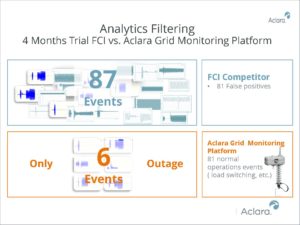The push to modernize the aging distribution grids and the need to bring low-carbon renewable technologies onto grids has sparked a new demand for distribution monitoring solutions. Traditional legacy fault current indicators (FCIs or FPIs as they are known in Europe) were a go-to technology in the past, but today utilities have realized that these devices have limited capabilities and are falling short of meeting their needs for real-time monitoring in the following ways:
- Legacy FCIs are not as accurate as smart grid sensors and provide very limited fault information
- Legacy FCIs cannot predict future faults because they do not have Predictive Grid® analytics
- Legacy FCIs are a point solution, whereas smart grid sensors can support multiple applications
- Legacy FCI’s have hidden costs that make the total cost of ownership more expensive than sensors
Throughout the course of this four-part blog series, we will address each of the reasons to conclude why smart grid line sensors are a better investment than legacy FCIs. To kick off the series, we dive into why you should care about having the most accurate and intelligent solution and why Aclara’s Grid Monitoring Platform is a more accurate and valuable fault mitigation solution than legacy FCIs.
Data and analytics make a difference
Both traditional legacy FCIs and smart grid sensors are used by utilities to detect faults on distribution lines. However, as shown in the diagram below, legacy FCI’s do not have the necessary metrology and analytics to filter out false alarms. During a 4-month field trial comparing FCI’s and smart grid sensors deployed on the same circuits, the results of reported fault alarms were compared. Over the course of the trial, FCIs reported 87 different fault events. The smart grid sensors reported all the same events.
However, the smart-grid-sensor solution determined that only six of the events were actual outage events. The remaining 81 events were classified as other forms of transient events and disturbances that did not require immediate dispatch of a troubleman. The conclusion was that use of legacy FCIs can result in significant numbers of false positives and additional operational expenses related to sending crews to chase the false alarms or leading linemen down the wrong path when searching for the source of faults.

Better filter out false alarms with smart grid sensors
The smart grid sensors that are part of the Aclara Grid Monitoring platform, on the other hand, are not stand-alone, but part of an integrated solution with our sensor management system (SMS) with Predictive Grid analytics – a giant technological leap forward from legacy FCI’s in accuracy and filtering out false alarms. When legacy FCI’s were put in head-to-head trials against Aclara smart grid sensors, they generated as many as four false alarms to every true outage event confirmed by our SMS.
By reducing false alarms, the Aclara Grid Monitoring platform is trusted by some of the world’s largest utilities to dispatch crews and to provide accurate data to other back-end systems such as SCADA, data historians, outage management systems, and advanced distribution management systems.
Analytical processing leads to better accuracy
The Aclara Grid Monitoring Platform with Predictive Grid analytics is more accurate than alternative solutions because it takes smart grid sensor data through four layers of analytical processing to improve accuracy and effectiveness. These four layers include:
- Layer 1: Event capture
- Layer 2: Event classification
- Layer 3: Trending, planning, and reporting
- Layer 4: Predictive Grid Analytics
When fault current is detected, waveforms of the event are captured along with some background information such as conductor phase ID, timestamp, GPS location, fault current, and the sustained or transient nature of the local event, which are communicated over a wireless or broadband network back to the SMS. The SMS application collects and correlates events from all reporting sensors on the circuit, classifies the event, and determines the fault location. The combined local and centralized smart solution builds a strong foundation for grid intelligence.
Additionally, Aclara SMS software classifies fault current events and disturbances that do not cause immediate outages in an effort to build intelligence about conditions that might cause a power failure in the future. For example, incidents like momentaries or transient line disturbances are categorized separately from outages. Each category of events can also be filtered to show trends over time across all circuits. The rules-based engine, which is a key component of our Predictive Grid analytics software, can detect:
- Outages due to blown fuses or overhead laterals
- Phase load imbalance
- Blown capacitor bank fuses
- Blown fuses from vegetation/animal disturbances
- Improper coordination of circuit protection timing
- Slack span faults
- Waveform pattern analysis
The results are more sophisticated than legacy FCIs or FPIs and provide better identification of faults on both feeders and laterals. Aided by such a solution, utilities can promptly spot a fault’s location, leading to faster repair and power restoration, often even prior to the customer calling to report a power outage with the utility. This greatly increases the technology’s accuracy and helps operations and distribution engineers get better, more trustworthy information to the field (Read how DTE Energy and UKPN are using sensors to modernize their distribution network).
Finally, smart sensors provide the added benefit of reporting fault oscillography. Not only can smart sensors report fault current waveforms, but they can also report either voltage or eField (electric field) fault waveforms as well. While these fault waveforms are used by sensors and the SMS software to perform fault analysis, they can be invaluable as a forensics tool for the troubleshooting of more complicated and repeated fault events. Just like x-rays and advanced imaging scans are now indispensable tools for doctors to diagnose a wide range of medical issues, so too are the benefits of logged fault waveforms to aid protection and power quality engineers in quickly diagnosing the root cause of more complex fault events. The adage “a picture is worth a thousand words” holds true.
We will republish the second installment of our blog series on Aclara’s Predictive Grid analytics and its importance in preventing outages in two weeks.
This blog series was originally published in 2018 and was significantly updated in February 2021.

